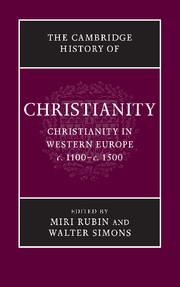
- Cited by 6
-
Cited byCrossref Citations
This Book has been cited by the following publications. This list is generated based on data provided by Crossref.
Cevins, Marie-Madeleine de and Matz, Jean-Michel 2010. Structures et dynamiques religieuses dans les sociétés de l’Occident latin (1179-1449). p. 9.
2010. Books Received. The Journal of Ecclesiastical History, Vol. 61, Issue. 1, p. 219.
2012. Books Received. Speculum, Vol. 87, Issue. 2, p. 640.
Gang, Song 2018. The Many Faces of Our Lady. Monumenta Serica, Vol. 66, Issue. 2, p. 303.
Palombaro, Ottavio 2021. A Fruitful or Wild French Vineyard? Distinguishing the Religious Roots of Albigenses and Waldensians in the Twelfth Century. Socio-Historical Examination of Religion and Ministry, Vol. 3, Issue. 1, p. 54.
Asakitikpi, Aretha Oluwakemi 2024. A Pragmatic Approach to Religion And Sustainability. Vol. 15, Issue. , p. 323.
- Publisher:
- Cambridge University Press
- Online publication date:
- March 2010
- Print publication year:
- 2009
- Online ISBN:
- 9781139056021
- Collection:
- Cambridge Histories - Religion


